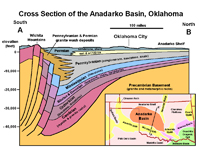The Anadarko Basin is one of the deepest sedimentary basins in North America, about 40,000 feet near its deepest point near Anadarko, Oklahoma (Figure 69). The basin covers about 50,000 square miles in western Oklahoma and part of the Texas Panhandle region. The Anadarko Basin is important in that it is the most productive natural gas production region of the United States. The basin is also a source of petroleum. Production of oil and natural gas occurs both in the basin and along the surrounding flanking margins. The oil and gas field brines are the main commercial source of iodine in the United States. The Anadarko Basin is also the major source of helium (extracted from the natural gas). Current thought is that the helium is derived from the decay of radioactive elements in the ancient granite wash deposits buried along the flank of the Wichita Uplift.
The Anadarko Basin formed in Late Paleozoic time as part of the Southern Oklahoma Aulacogen—the structural basin sank and filled with sediments shed from surrounding rising uplifts in the region, primarily during Pennsylvanian time (concurrent with the Ouachita Orogeny). The deepest part of the basin is adjacent to the Wichita Mountains-Amarillo Uplift on its southern margin. The basin is bounded on northeast by the Nemaha Ridge (a buried uplift), and by the Amarillo Uplift and Cimarron Arch (also buried uplifts) to the west and northwest.
At the time of the writing of this report, Oklahoma, partially parts of the Anadarko Basin, have been experience an abundance of low-to-moderate magnitude earthquakes. The earthquakes have been "attributed" (proving is difficult) to the increased intensity of drilling and fracking taking place in the Anadarko region. Current thought is that the drilling and fracking activity is releasing potential energy associated with old fault systems
in the region, currently making Oklahoma the most seismically active region in the United States. |
 Fig. 69. North-south cross section of the Anadarko Basin, Oklahoma. Fig. 69. North-south cross section of the Anadarko Basin, Oklahoma. |
